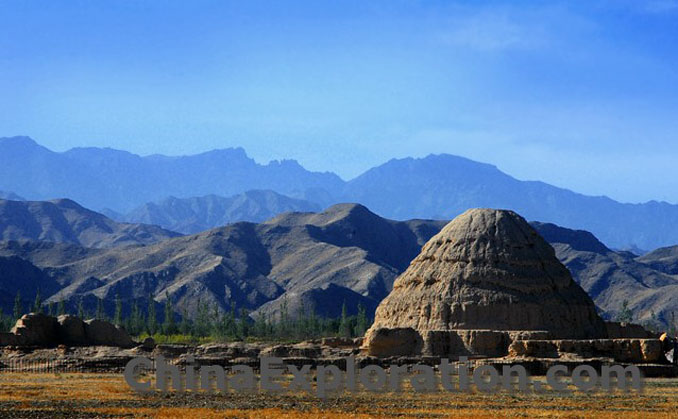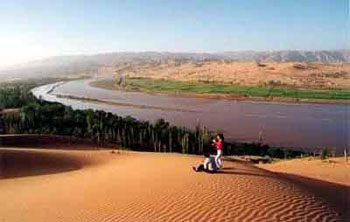search for a Trip

Yinchuan is a breath of fresh air. As capital of the Ningxia Hui Autonomous Region, it has a population under a million, its tree-lined streets still have relatively few automobiles, and it is rumored to be the quietest city in China. It has also escaped the extreme poverty associated with this province by having the good fortune to be hydrated by the Yellow River and an irrigation system first built during the Han dynasty. Over a third of the region's population is Hui (Chinese Muslims), and a significant percentage live in the capital, adding a cultural diversity less apparent in other Chinese capitals.
Ningxia Hui Autonomous Region, “Ning” for short, founded on October 25th, 1958, is the one and only Hui autonomous region in China. Ningxia is located in the middle reaches of the Yellow River in northwest China,. It is bordered on Shaanxi Province to the east, Inner Mongolia Autonomous Region to the north and Gansu Province to the west and the south, with the total area of 66 400 sq. km. With a population of 5.95 million and 2.02 million, it is inhabited by 35 peoples.
Western Xia Mausoleum
 Located at the eastern foot of Mt. Helan, the Western Xia Mausoleum covers an area of 40 sq. km, dotted with tombs of nine kings and more than 70 annex tombs enormous in scale and strange in shape, esp, the 20-metre-high octagonal shaped mausoleums, are dubbed as Pyramids in China. The Royal Mausoleum of the Western Xia State reflects a splendid civilization created by Western Xia Kingdom (1038-1228) , who had taken Xingqing what is Yinchuan today as its capital. The region borders the Yellow River in the east, Yumen in Gansu province in the west, Xiaoguan in Gansu province in the south and vast desert in the north, spanning thousands of kilometers’ territory and clinging against Helan Mountains which were known as the imperial hunting garden during that period and had imperial palaces like Xanadu and temples built there. Helan Mountains abound in steep cliffs and sea of pine trees. At the top of the mountain people can have a bird view of Yinchuan Plain with the belt-shaped Yellow River, net-woven channels and roads, patches of cornfields sprinkled on it, revealing the picturesque scenery of mild beauty in South China. In order to revitalize the ever-beautiful site, the local government has set light and audio facilities on buildings. When night falls, the yellow and blue lights reflect on the walls and turrets, bringing people into a magic world.
Located at the eastern foot of Mt. Helan, the Western Xia Mausoleum covers an area of 40 sq. km, dotted with tombs of nine kings and more than 70 annex tombs enormous in scale and strange in shape, esp, the 20-metre-high octagonal shaped mausoleums, are dubbed as Pyramids in China. The Royal Mausoleum of the Western Xia State reflects a splendid civilization created by Western Xia Kingdom (1038-1228) , who had taken Xingqing what is Yinchuan today as its capital. The region borders the Yellow River in the east, Yumen in Gansu province in the west, Xiaoguan in Gansu province in the south and vast desert in the north, spanning thousands of kilometers’ territory and clinging against Helan Mountains which were known as the imperial hunting garden during that period and had imperial palaces like Xanadu and temples built there. Helan Mountains abound in steep cliffs and sea of pine trees. At the top of the mountain people can have a bird view of Yinchuan Plain with the belt-shaped Yellow River, net-woven channels and roads, patches of cornfields sprinkled on it, revealing the picturesque scenery of mild beauty in South China. In order to revitalize the ever-beautiful site, the local government has set light and audio facilities on buildings. When night falls, the yellow and blue lights reflect on the walls and turrets, bringing people into a magic world.
Shapotou
It is about 20 kilometers west to Zhongwei County and on the southern rim of the Tengger Desert. Shapotou lies on the bank of the Yellow River and won its name by a 2 000-metre-wide, 100-metre-high dune formed in Qing Dynasty Emperor Qianlong’s reign (1736―1795). The big dune with a pitch of about 60 degree gives a resonance that reverberates like the tolling of a huge bell or the beating of a big drum when sliding down, especially in fine days with high temperatures. The place therefore is entitled “Dune’s Tolling Bell” and becomes one of the four singing sands in China. Looking up from the foot of the sand mountain, one can see people sliding down like descending from the sky, or from a waterfall, and then those trivialities in life are totally driven away, only left the sand sound to enjoy, which reveal a vivid picture of the high and steep sand mountain, the magic sound when sliding down, the enjoyment of travelers, and the beauty of people drafting along the limpid Yellow River. Moreover, those experts combating desertification and people preventing the sands from encroaching onto the railways have made great contributions to the place’s sand control and tree planting for 40 years, making the place more famous around the world. Shapotou has combined natural beauty, humanity efforts and achievements of combating desertification together and won the titles of “world’s sand capital” and the “world’s unique tourist resource”. All of these qualities belong to Shapotou, one of the state’s top level tourist sites confirmed in 2000 and it is the pride of Ningxia people with world’s reputation.
Sand lake
 The Sand Lake tourist area is 56 km away north of Yinchuan City and 30 km south of Shizuishan City. With a total area of 45.1 sq. km, the Sand Lake is made up of 8.2 sq. km of lake and 12.7 sq. km of golden desert. The area excels in natural beauties, characterized by the integration of sand, water, reed, bird and hill, forming a scenic pearl combined China’s lush southern-type view and the northern-frontier scene as a whole. Jiang Zemin even inscribed the two characters “Sand Lake” (沙湖) and sang high praise for the place. Today, the Sand Lake is listed as one of the 35 national tourist trump cards and has become a major destination for travel and investment in west China.
The Sand Lake tourist area is 56 km away north of Yinchuan City and 30 km south of Shizuishan City. With a total area of 45.1 sq. km, the Sand Lake is made up of 8.2 sq. km of lake and 12.7 sq. km of golden desert. The area excels in natural beauties, characterized by the integration of sand, water, reed, bird and hill, forming a scenic pearl combined China’s lush southern-type view and the northern-frontier scene as a whole. Jiang Zemin even inscribed the two characters “Sand Lake” (沙湖) and sang high praise for the place. Today, the Sand Lake is listed as one of the 35 national tourist trump cards and has become a major destination for travel and investment in west China.
Xu Nishan Grotto
It lies in the east of Xuni Mountain in northwestern Guyuan, which is a rare scenery spot in loess plateau with rounding ranges of hills, thick forest, rivers and lakes. There are many images of Buddha with exquisite carvings, each having its own style in the splendid grotto. The valuable grotto artistic images like the Great Buddha Building, Palace of Offsprings, Yuanguang Temple, Minister’s Temple and Peach Blossom Cave of the North dynasty, Sui dynasty and Tang dynasty were cut on the peaks of the five linked mountains around 2 km long and 1 km wide. There are also many records of Tang, Song, Xixia dynasties here, which are the precious materials to study the social history at that time. Xuni Mountain Grotto, together with Dunhuang Grotto, Yungang Grotto, Longmen Grotto, Maiji Mountain Grotto, is the precious treasure of our ancient cultural heritage.
Liupan Mountains
Liupan Mountains: The place is known as the “Green Pearl” on the Loess Plateau for its lush vegetation, beautiful scenery and abundant rare animals. It is also well known due to the fact that Mao Zedong wrote the famous poem Liupan Mountains in 1935 when he led his Red Army tramping over the mountain. Liupan Mountains National Forest Park is one of the most important bases in holding waters on Northwest China, with an area of about 67 800 ha., covering three counties including Jinyuan, Guyuan and Longde. More than 70 percent of the mountain is covered with forest and it has so diverse species that it becomes a gigantic species warehouse. Lush forest, verdant vegetation and diverse species make the park becoming an ideal place for travel, summer resort, adventure and scientific studies. It has as many as more than 60 scenic spots such as Laolongtan (Old Dragon Pool), Erlonghe (Two Dragon River), Guimenguan (Ghost Gate Pass), Liangdianxia (Cool Palace Gorge), Yehegu (Wild Valley), Tianchi (Sky Pond) and Baiyunshan (Baiyun Mountains). With its special geographical location, waterfalls and springs, the place reveals unparalleled natural beauties circled by mountains. Steep mountains and pretty lakes here have created picturesque scenery with lush southern-type view and the northern-frontier scene, which changes its views according to variation of seasons.
Climate of Yinchuan
|
Month |
Jan |
Feb |
Mar |
Apr |
May |
Jun |
Jul |
Aug |
Sep |
Oct |
Nov |
Dec |
|
Temperature (Celsius) |
-3.1 |
-2.3 |
5.5 |
10.1 |
14.8 |
19.0 |
30.8 |
29.4 |
24.4 |
16.4 |
12.1 |
6.7 |
Click to see Yinchuan tours
China Attractions Guide
- Anhui Attractions
- Beijing Attractions
- Chongqing Attractions
- Fujian Attractions
- Gansu Attractions
- Guangdong Attractions
- Guangxi Attractions
- Guizhou Attractions
- Hainan Attractions
- Henan Attractions
- Hongkong Attractions
- Hubei Attractions
- Hunan Attractions
- Inner Mongolia Attractions
- Jiangsu Attractions
- Jiangxi Attractions
- Manchuria Attractions
- Ningxia Attractions
- Qinghai Attractions
- Shaanxi Attractions


